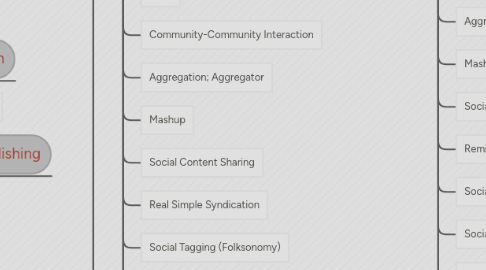
1. Online Network Learning Environment (ONLE) Instructional Strategies
1.1. Participatory Web
1.2. UGC
1.3. Community-Community Interaction
1.4. Aggregation; Aggregator
1.5. Mashup
1.6. Social Content Sharing
1.7. Remix
1.8. Social Tagging (Folksonomy)
1.9. Social Networking
1.10. InfoViz: Information Visualization
1.11. Mobile Learning; Ubiquitous Learning
1.12. Cloud Computing
1.13. Augmented Reality
1.14. Geolocation-based Learning; Location-based Learning
1.15. Game-based Learning
2. Online Instructional Learning Strategies: What do these strategies look like inside of an ONLE?
2.1. Learner-Learner Interaction
2.1.1. Participatory Web
2.1.2. UGC
2.1.3. Community-Community Interaction
2.1.4. Aggregation; Aggregator
2.1.5. Mashup
2.1.6. Social Content Sharing
2.1.7. Real Simple Syndication
2.1.8. Social Tagging (Folksonomy)
2.1.9. Social Networking
2.1.10. InfoViz: Information Visualization
2.1.11. Mobile Learning; Ubiquitous Learning
2.1.12. Cloud Computing
2.1.13. Augmented Reality
2.1.14. Geolocation-based Learning; Location-based Learning
2.1.15. Game-based Learning
2.2. Learning Resources
2.2.1. Participatory Web
2.2.2. UGC
2.2.3. Community-Community Interaction
2.2.4. Aggregation; Aggregator
2.2.5. Mashup
2.2.6. Social Content Sharing
2.2.7. Remix
2.2.8. Real Simple Syndication
2.2.9. Social Tagging (Folksonomy)
2.2.10. Social Networking
2.2.11. InfoViz: Information Visualization
2.2.12. Mobile Learning; Ubiquitous Learning
2.2.13. Geolocation-based Learning; Location-based Learning
2.2.14. Game-based Learning
2.3. Online Collaboration
2.3.1. Participatory Web
2.3.2. UGC
2.3.3. Community-Community Interaction
2.3.4. Mashup
2.3.5. Social Content Sharing
2.3.6. Remix
2.3.7. Real Simple Syndication
2.3.8. Social Tagging (Folksonomy)
2.3.9. Social Networking
2.3.10. InfoViz: Information Visualization
2.3.11. Mobile Learning; Ubiquitous Learning
2.3.12. Cloud Computing
2.3.13. Game-based Learning
2.4. Online Learning Community
2.4.1. Participatory Web
2.4.2. UGC
2.4.3. Community-Community Interaction
2.4.4. Aggregation; Aggregator
2.4.5. Mashup
2.4.6. Social Content Sharing
2.4.7. Remix
2.4.8. Real Simple Syndication
2.4.9. Social Tagging (Folksonomy)
2.4.10. Social Networking
2.4.11. InfoViz: Information Visualization
2.4.12. Mobile Learning; Ubiquitous Learning
2.4.13. Augmented Reality
2.4.14. Geolocation-based Learning; Location-based Learning
2.4.15. Game-based Learning
2.5. Online Student Publishing
2.5.1. Participatory Web
2.5.2. UGC
2.5.3. Mashup
2.5.4. Social Content Sharing
2.5.5. Remix
2.5.6. Social Tagging (Folksonomy)
2.5.7. Social Networking
2.5.8. InfoViz: Information Visualization
2.5.9. Mobile Learning; Ubiquitous Learning
2.5.10. Cloud Computing
2.6. Peer Evaluation
2.6.1. Participatory Web
2.6.2. UGC
2.6.3. Community-Community Interaction
2.6.4. Mashup
2.6.5. Social Content Sharing
2.6.6. Social Tagging (Folksonomy)
2.6.7. Social Networking
2.6.8. InfoViz: Information Visualization
2.6.9. Mobile Learning; Ubiquitous Learning
2.6.10. Cloud Computing
3. ONLE Instructional Strategies: What online instructional strategies are utilized in each of these strategies?
3.1. Participatory Web
3.1.1. Learner-Learner Interaction
3.1.2. Learning Resources
3.1.3. Online Collaboration
3.1.4. Online Learning Community
3.1.5. Online Student Publishing
3.1.6. Peer Evaluation
3.2. UGC
3.2.1. Learner-Learner Interaction
3.2.2. Learning Resources
3.2.3. Online Collaboration
3.2.4. Online Learning Community
3.2.5. Online Student Publishing
3.2.6. Peer Evaluation
3.3. Community-Community Interaction
3.3.1. Learner-Learner Interaction
3.3.2. Learning Resources
3.3.3. Online Collaboration
3.3.4. Online Learning Community
3.3.5. Peer Evaluation
3.4. Aggregation; Aggregator
3.4.1. Learner-Learner Interaction
3.4.2. Learning Resources
3.4.3. Online Learning Community
3.5. Mashup
3.5.1. Learner-Learner Interaction
3.5.2. Learning Resources
3.5.3. Online Collaboration
3.5.4. Online Learning Community
3.5.5. Online Student Publishing
3.5.6. Peer Evaluation
3.6. Social Content Sharing
3.6.1. Learner-Learner Interaction
3.6.2. Learning Resources
3.6.3. Online Collaboration
3.6.4. Online Learning Community
3.6.5. Online Student Publishing
3.6.6. Peer Evaluation
3.7. Remix
3.7.1. Learning Resources
3.7.2. Online Collaboration
3.7.3. Online Learning Community
3.7.4. Online Student Publishing
3.8. Real Simple Syndication
3.8.1. Learner-Learner Interaction
3.8.2. Learning Resources
3.8.3. Online Collaboration
3.8.4. Online Learning Community
3.9. Social Tagging (Folksonomy)
3.9.1. Learner-Learner Interaction
3.9.2. Learning Resources
3.9.3. Online Collaboration
3.9.4. Online Learning Community
3.9.5. Online Student Publishing
3.9.6. Peer Evaluation
3.10. Social Networking
3.10.1. Learner-Learner Interaction
3.10.2. Learning Resources
3.10.3. Online Collaboration
3.10.4. Online Learning Community
3.10.5. Online Student Publishing
3.10.6. Peer Evaluation
3.11. InfoViz: Information Visualization
3.11.1. Learner-Learner Interaction
3.11.2. Learning Resources
3.11.3. Online Collaboration
3.11.4. Online Learning Community
3.11.5. Online Student Publishing
3.11.6. Peer Evaluation
3.12. Mobile Learning; Ubiquitous Learning
3.12.1. Learner-Learner Interaction
3.12.2. Learning Resources
3.12.3. Online Collaboration
3.12.4. Online Learning Community
3.12.5. Online Student Publishing
3.12.6. Peer Evaluation
3.13. Cloud Computing
3.13.1. Learner-Learner Interaction
3.13.2. Online Collaboration
3.13.3. Online Student Publishing
3.13.4. Peer Evaluation
3.14. Augmented Reality
3.14.1. Learner-Learner Interaction
3.14.2. Online Learning Community
3.15. Geolocation-based Learning; Location-based Learning
3.15.1. Learner-Learner Interaction
3.15.2. Learning Resources
3.15.3. Online Learning Community
3.16. Game-based Learning
3.16.1. Learner-Learner Interaction
3.16.2. Learning Resources
3.16.3. Online Collaboration
3.16.4. Online Learning Community

